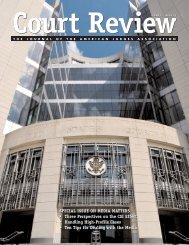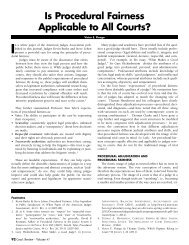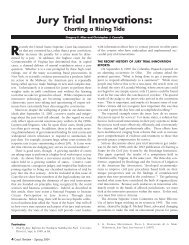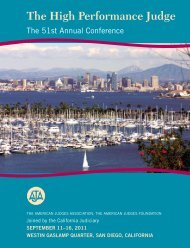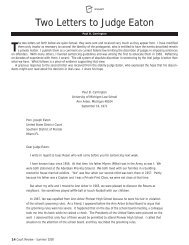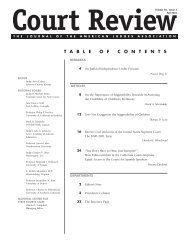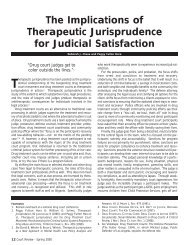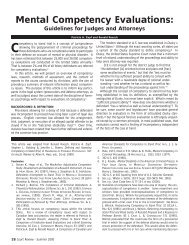Special Issue on Procedural Fairness - American Judges Association
Special Issue on Procedural Fairness - American Judges Association
Special Issue on Procedural Fairness - American Judges Association
- No tags were found...
Create successful ePaper yourself
Turn your PDF publications into a flip-book with our unique Google optimized e-Paper software.
[T]he AOC willbe better able toidentify the effectsof best practices orprocess changesthat are drivingthe results.ability instruments is currentlybeing linked withimproving public trust andc<strong>on</strong>fidence. Although not formallyincluded in the proceduralfairness initiative at thistime, these tools are helpingmeasure the achievement ofprocedural fairness and aredem<strong>on</strong>strating branchaccountability. Measure 1,Access and <strong>Fairness</strong>, uses a survey to measure individual satisfacti<strong>on</strong>with the ability to make use of the court’s dispute resoluti<strong>on</strong>services (access) and how the legal process dealt withtheir issue, interest, or case (fairness). Survey c<strong>on</strong>tent for courtusers in Measure 1 reflects elements of procedural fairness andrelates to the goals of the initiative. For example:• The way my case was handled was fair.• The judge listened to my side of the story before he orshe made a decisi<strong>on</strong>.• The judge had the informati<strong>on</strong> necessary to make gooddecisi<strong>on</strong>s about my case.• I was treated the same as every<strong>on</strong>e else.• As I leave the court, I know what to do next about mycase.Measure 1 has been tested in four courts around the state,and the number of participating courts is expected to grow.Current plans are under way for several California courts topilot the Measure 1 survey to gauge court user satisfacti<strong>on</strong> withtheir court experience and solicit suggesti<strong>on</strong>s for serviceimprovements. The AOC is working closely with the NCSC toreduce the resources needed to implement the surveys. Bybringing the survey instrument and the collecti<strong>on</strong> process toscale across multiple jurisdicti<strong>on</strong>s using the same data collecti<strong>on</strong>tool, the AOC will be better able to identify the effects ofbest practices or process changes that are driving the results.After three years of c<strong>on</strong>ducting the Measure 1 survey, theSuperior Court of Santa Mateo County is c<strong>on</strong>sidering makingpublic the results <strong>on</strong> its Web page to increase public trust andc<strong>on</strong>fidence, dem<strong>on</strong>strate accountability to the public, andmake the survey process and results transparent. As the initiativedevelops, we will be looking to this and other methods toevaluate the success of procedural fairness efforts taking placein the California courts.Current Court Programs Highlighting <strong>Procedural</strong><strong>Fairness</strong>. In additi<strong>on</strong> to increasing the use of accountabilityinstruments to help meet public expectati<strong>on</strong>s regarding thereporting of court performance, other innovati<strong>on</strong>s are alreadytaking place within the California courts. Both of the courtprograms highlighted below received the 2006–2007 Ralph N.Kleps Award for Improvement in the Administrati<strong>on</strong> of theCourts, established in 1991 in h<strong>on</strong>or of the firstAdministrative Director of the Courts in California. 6 TheKleps Awards recognize individual court innovati<strong>on</strong>s thatimprove the administrati<strong>on</strong> of justice. The award-winningprograms address important public needs and help dem<strong>on</strong>strateprocedural fairness in acti<strong>on</strong>.Recruiting Students to Help Court Users. The JusticeCorpsprogram is an innovative approach to addressing the needs ofa key court user group highlighted in the trust and c<strong>on</strong>fidencesurvey: self-represented litigants. JusticeCorps recruits andtrains 275 diverse university students annually to augmentoverburdened court and legal aid staff who assist self-representedlitigants in court-based self-help programs in selectlocati<strong>on</strong>s throughout California.In resp<strong>on</strong>se to the flood of self-represented litigants accessingthe self-help programs of the Superior Court of LosAngeles County, the court, in partnership with the AOC, c<strong>on</strong>ceivedJusticeCorps, which trains and provides an educati<strong>on</strong>alstipend for university students who commit to a full academicyear of service in court-based self-help centers. These highlymotivated and well-trained students provide in-depth andindividualized services to self-represented litigants, often intheir native languages.For the pilot project in 2004, the court initially partneredwith four universities—the University of California at LosAngeles and California State Universities at Northridge,Dominguez Hills, and Pom<strong>on</strong>a—four n<strong>on</strong>profit legal-aid agencies,and the Los Angeles County Small Claims Advisor. Withthe help of AOC staff, the court obtained funding fromAmeriCorps for JusticeCorps.Each year, the Los Angeles program places 150 students ineight court-based self-help centers throughout Los AngelesCounty. Students agree to serve at least 300 hours in a year,during which they:• Triage l<strong>on</strong>g lines at court-based self-help centers todetermine each litigant’s need and degree of urgency andhelp litigants complete the proper forms;• Make referrals to other court services;• Teach people to use self-help computer resources; and• Provide services to litigants after hearings.Parties are given clear informati<strong>on</strong> and opti<strong>on</strong>s and thenc<strong>on</strong>nected quickly to the right resources. Litigants are assistedin completing appropriate and accurate pleadings, writtenorders, and judgments under attorney supervisi<strong>on</strong> and, in theprocess, provided with a better understanding of the court system.Many of these litigants have low literacy skills, whichhampers their ability to fill out forms, participate in self-helpworkshops, or use computerized resources.In short, the volunteers enhance the quality and the quan-6. Informati<strong>on</strong> about innovative programs and initiatives that helpthe California courts c<strong>on</strong>tinue to improve access to justice,including the JusticeCorps and ACTION programs describedhere, is drawn from JUDICIAL COUNCIL OF CALIFORNIA, INNOVATIONSIN THE CALIFORNIA COURTS: STRENGTHENING THE JUDICIAL BRANCH(2007), available at http://www.courtinfo.ca.gov/programs/innovati<strong>on</strong>s.52 Court Review - Volume 44



